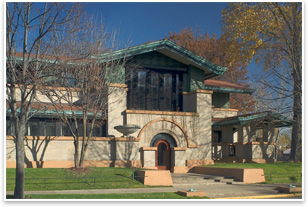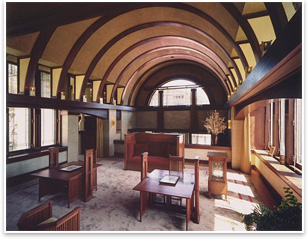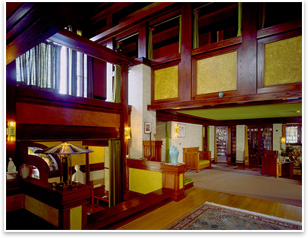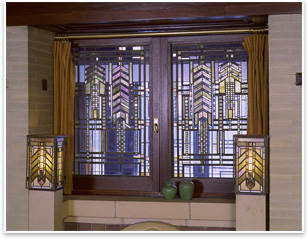Illinois to Close FLW’s Dana-Thomas House, Other Historic Sites and Parks
Properties set to close to public December 1
by Tracy Ostroff
Contributing Editor
 How do you . . . navigate the political realities of architecture to save valuable buildings? How do you . . . navigate the political realities of architecture to save valuable buildings?
Summary: Frank Lloyd Wright’s Dana-Thomas House, which ranks 114th on the list of the AIA’s America’s Favorite Architecture, is set to close December 1. The property is one of 11 historic sites and 14 parks that are affected by budget cuts in Illinois. A bill to restore funding for the properties is pending before the governor now; the legislation’s fate is unclear.
 If the governor fails to sign the bill, which he has 60 days to do once he receives it from the state senate, it will cost hundreds of state employees their jobs and leave the properties closed, with minimal oversight. With inadequate personnel on site, preservationists fear the buildings will fall into disrepair. If the governor fails to sign the bill, which he has 60 days to do once he receives it from the state senate, it will cost hundreds of state employees their jobs and leave the properties closed, with minimal oversight. With inadequate personnel on site, preservationists fear the buildings will fall into disrepair.
“We’re caught in the middle of a terrible political battle in our state,” explains Regina Albanese, executive director of the Dana-Thomas House Foundation. The governor slashed funds for the Illinois Historic Preservation Agency to help balance the state budget, she says. Representatives and senators have worked hard to restore funding, even coming back for a special session to pass quickly the current bill that is pending now before Gov. Rod Blagojevich. Albanese and others are still encouraging people to contact the governor to express support for the legislation.
In addition to the Dana-Thomas House, a National Landmark, the cuts affect 11 historic sites that represent a wide range of styles, from the grand Victorian-style David Davis House in Bloomington to three buildings in Bishop Hill and the state’s first capitol building in Vandalia.
 Bad deal for taxpayers Bad deal for taxpayers
“The response from the public is everything you could expect it to be,” Albanese says. Many different organizations, including AIA Illinois and its local components, have rallied to support the properties. AIA Illinois Executive Director Mike Waldinger notes that several of the sites are on the chapter’s list of Illinois Great Places, the chapter’s AIA150 project.
The cuts are particularly painful at the Dana-Thomas House, which the state had purchased in 1981 for significantly less than could have been earned had the household been broken up. According to a story in the Springfield State Journal-Register it was restored in the late 1980s and opened to the public in 1990, after a multi-year, award-winning restoration that brought the house back to its 1906 appearance. It is believed to be the best-preserved example of Wright’s “Prairie period” dwellings and contains one of the most intact Wright architectural interiors in the U.S. Albanese says the collections inside the house are valued in the tens of millions of dollars.
“The state invested money into the site, and now the public won’t see it,” says Jim Peters, president and CEO of Landmarks Illinois. “These aren’t just budget cuts, it is the removal of history that impacts education, tourism revenue, the economic viability of the state, and jobs.” Waldinger and Albanese say it’s a real blow to local economies, which thrive on tourism dollars.
 “Mothballed” “Mothballed”
At the Dana-Thomas House, the care of the property would be left to the site director. They have been told the utilities will stay on. Albanese worries about ongoing maintenance. Waldinger and Peters also are concerned that once a building closes it doesn’t do as well, structurally or financially. Everyone fears that the extremely valuable collection of the site will be at risk.
“Any way you look at it, it’s hard to reinvest in culture once you close the place down,” Waldinger says. He points to volunteer and marketing programs for repeat visitors that would suffer, and to federal money that could be lost. “Once you lose public interest in the sites it is hard to generate money to protect them for future generations.”
That is also a sticking point for the sites’ advocates. They say there is no rhyme or reason to the cuts, and they disagree that there will be any savings to the state as a result of closing the Dana-Thomas House, once lost revenues are considered.
 There is hope, and a Plan B, and a Plan C, Waldinger says, if the governor does not sign the bill, the sites will reopen once the new budget season begins and funding can be included in larger spending bills. In the meantime, Peters says the governor’s actions send the message that “our sites are closed for business.” There is hope, and a Plan B, and a Plan C, Waldinger says, if the governor does not sign the bill, the sites will reopen once the new budget season begins and funding can be included in larger spending bills. In the meantime, Peters says the governor’s actions send the message that “our sites are closed for business.”
The value of architecture
The closings and cuts, “sends a message to the public that we’re expendable … this could happen to any architecturally significant property that is government owned. We did not expect to be a political football,” Albanese says.
“If people are going to be interested in the world around them,” Waldinger notes, “we have to preserve the best examples of the built environment and the natural environment.”
AIA Illinois hosted exhibits for America’s Favorite Architecture and Illinois Great Places. Waldinger says the events helped explain and highlight the best examples of architecture and Illinois. It helps when things like this happen, to show people it’s not just any old building, but one with a legacy that is worth fighting for. |


 How do you . . .
How do you . . . If the governor fails to sign the bill, which he has 60 days to do once he receives it from the state senate, it will cost hundreds of state employees their jobs and leave the properties closed, with minimal oversight. With inadequate personnel on site, preservationists fear the buildings will fall into disrepair.
If the governor fails to sign the bill, which he has 60 days to do once he receives it from the state senate, it will cost hundreds of state employees their jobs and leave the properties closed, with minimal oversight. With inadequate personnel on site, preservationists fear the buildings will fall into disrepair. Bad deal for taxpayers
Bad deal for taxpayers “Mothballed”
“Mothballed” There is hope, and a Plan B, and a Plan C, Waldinger says, if the governor does not sign the bill, the sites will reopen once the new budget season begins and funding can be included in larger spending bills. In the meantime, Peters says the governor’s actions send the message that “our sites are closed for business.”
There is hope, and a Plan B, and a Plan C, Waldinger says, if the governor does not sign the bill, the sites will reopen once the new budget season begins and funding can be included in larger spending bills. In the meantime, Peters says the governor’s actions send the message that “our sites are closed for business.”